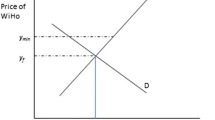Abstract
This paper promotes research methods specific to men, the new focus of fertility and family planning studies (especially in sub-Saharan Africa). I propose a novel marriage categorization based on married men’s intentions to take another wife. The three marriage groups are currently monogamous men who intend to remain so, currently monogamous men who intend to become polygynous, and currently polygynous men. The first analysis demonstrates that typical marriage analyses may misclassify men who intend to become polygynous. Applications of the marriage trichotomy illustrate that men with varying marital intentions have differing desires regarding fertility and family planning.
Similar content being viewed by others
References
Adamchak, D.J. and A. Adebayo. 1987. “Male Fertility Attitudes: A Neglected Dimension in Nigerian Fertility Research.” Social Biology 34:57–67.
Balépa, M., M. Fotso, and B. Barrère, 1992. Cameroun. Enquête Démographique et de Santé, Cameroun, 1991. Yaoundé, Cameroun: Direction Nationale du Deuxiême Recensement Général de la Population et de l’Habitat Columbia, MD: Macro International.
Blake, J. 1983. “Book Review: World Fertility Survey Conference 1980: Record of Proceedings.” Population and Development Review 9:153–56.
Brown, J.E. 1981. “Polygyny and Family Planning in Sub-Saharan Africa.” Studies in Family Planning 12:322–26.
Burnham, P. 1987. “Changing Themes in the Analysis of African Marriage.” Pp. 37–54 in Transformations of African Marriage, edited by D.1. Parkin and D. Nyamwaya. Manchester, UK: Manchester University Press.
Caldwell, J.C. and P. Caldwell. 1990. “Cultural Forces Tending to Sustain High Fertility.” Pp. 199–214 in Population Growth and Reproduction in Sub-Saharan Africa: Technical Analyses of Fertility and Its Consequences, edited by G.T.F. Acsadi, G. Johnson-Acsadi, and R.A. Bulato. Washington, DC: World Bank.
Chojnacka, H. 1980. “Polygyny and the Rate of Population Growth.” Population Studies 34:91–107.
Donadje, F. and D. Tabutin. 1991. “Nuptialite et Fecondite des Hommes au Sud-Benin.” Seminar on the Course of Fertility Transition in Sub-Saharan Africa, Harare, Zimbabwe, 19–22 November: Papers. Liège: International Union for the Scientific Study of Population.
Fapohunda, E.R. and M.P. Todaro. 1988. “Family Structure, Implicit Contracts, and the Demand for Children in Southern Nigeria.” Population and Development Review 14:571–94.
Frank, O. and G. McNicoll. 1987. “An Interpretation of Fertility and Population Policy in Kenya.” Population and Development Review 13:209–43.
Hanushek, E.A. and J.E. Jackson. 1977. Statistical Methods for Social Scientists. New York: Academic Press.
Isiugo-Abanihe, U.C. 1994. “Reproductive Motivation and Family Size Preferences among Nigerian Men.” Studies in Family Planning 25:149–61.
Karanja, W.W. 1994. “The Phenomenon of ‘Outside Wives’: Some Reflections on Its Possible Influence on Fertility.” Pp. 194–214 in Nuptiality in Sub-Saharan Africa: Contemporary Anthropological and Demographic Perspective, edited by C.H. Bledsoe and G. Pison. Oxford, UK: Clarendon Press.
Lee, R.D. and R.A. Bulatao. 1983. “The Demand for Children: A Critical Essay.” Pp. 233-87 in Determinants of Fertility in Developing Countries, Vol. 1, edited by R.A. Bulatao and R.D. Lee with P.E. Hollebach and J.P. Bongaarts. New York: Academic Press.
Mason, K.O. and A.M. Taj. 1987. “Differences between Women’s and Men’s Reproductive Goals in Developing Countries.” Population and Development Review 13:611–38.
Mott, F.L. and S.H. Mott. 1985. “Household Fertility Decisions in West Africa: A Comparison of Male and Female Survey Results.” Studies in Family Planning 16:88–99.
Ngondo a Pitshandenge, I. 1994. “Marriage Law in Sub-Saharan Africa.” Pp. 117–29 in Nuptiality in Sub-Saharan Africa: Contemporary Anthropological and Demographic Perspective, edited by C.H. Bledsoe and G. Pison. Oxford, UK: Clarendon Press;
Orubuloye, I.O. 1993. “Women’s Control over Their Sexuality: Implications for STDs and HIV/AIDS Transmission in Nigeria.” Presented at International Union for the Scientific Study of Population, Seminar on Women and Demographic Change in Sub-Saharan Africa, Dakar.
Robbins, P.K. and K.P. Dickinson. 1985. “Child Support and Welfare Dependence: A Multinomial Logit Analysis.” Demography 22:367–80.
Speizer, I. 1994. “Men’s Desire for Additional Wives and Children in Cameroon.” Doctoral dissertation, Johns Hopkins University.
Trussell, T.J., E. van de Walle, and F. van de Walle. 1989. “Norms and Behaviour in Burkinabe Fertility.” Population Studies 43:429–54.
van de Walle, E. and F. van de Walle. 1988. “Birthspacing and Abstinence in Sub-Saharan Africa.” International Family Planning Perspectives 14:25–26.
Author information
Authors and Affiliations
Additional information
Permission to use these DHS data was granted by Macro International Inc. The research was undertaken while the author was on a National Institutes of Health training grant at Johns Hopkins University School of Hygiene and Public Health. Additional support was provided by a postdoctoral fellowship from the Andrew W. Mellon Foundation to conduct research at the Carolina Population Center at the University of North Carolina at Chapel Hill. I thank W. Henry Mosley and Nan M. Astone for their helpful suggestions.
Rights and permissions
About this article
Cite this article
Speizer, I.S. A marriage trichotomy and its applications. Demography 32, 533–542 (1995). https://doi.org/10.2307/2061673
Issue Date:
DOI: https://doi.org/10.2307/2061673




